Mission San Carlos Borromeo de Carmelo (CA Mission #2)
Introduction
Text-to-speech Audio
Images
A present-day view of the Mission. The Mission's church is built from locally quarried stone, though the original roof, destroyed in the 1800s, is a historically accurate restoration from 1936.
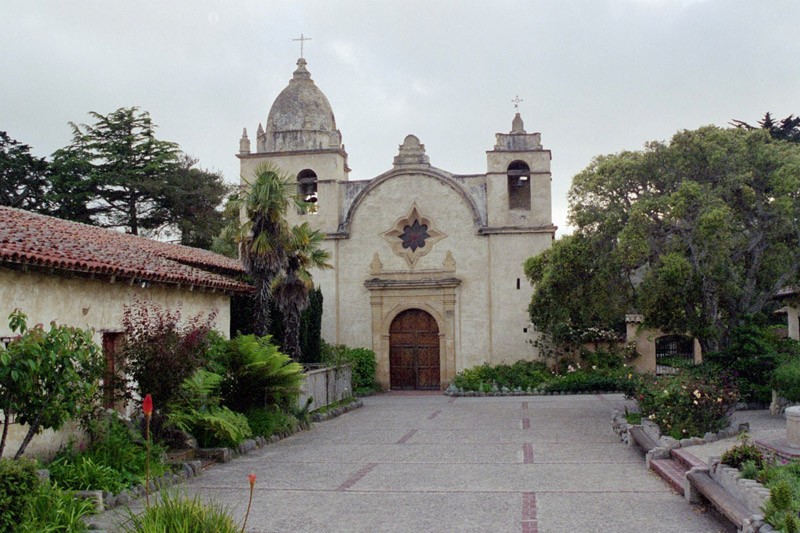
1880s photo of the Mission Carmel ruins. San Carlos Borromeo is the only Mission to retain its original bell and belltower.
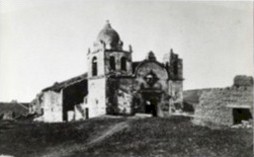
Bird's eye view of mission. The "quadrangle" to let of the basilica had to be rebuilt through painstaking restoration--the original was destroyed in the 1800s.
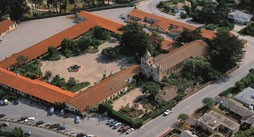
Padre Junipero Serra, first Presidente of the Missions. His canonization in 2015 by the Catholic Church led to widespread protests and vandalism at California Missions due to the Spanish history of forced labor and conversion of California Natives.

A statue of Padre Junipero Serra toppled at Mission San Carlos after his canonization in 2015.
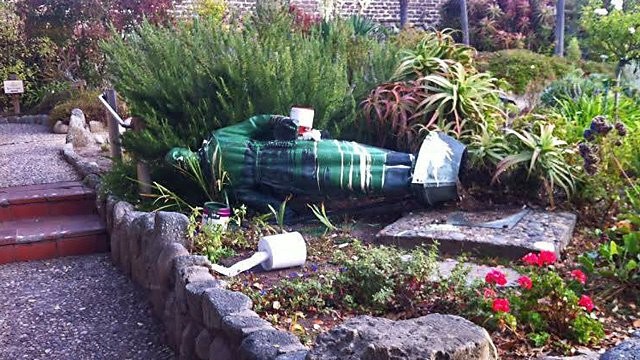
The grave of Padre Serra under the floor of the sanctuary inside the basilica. Buried alongside him are his successor, Padre Fermin Lasuen, and two other Franciscan friars from the era.
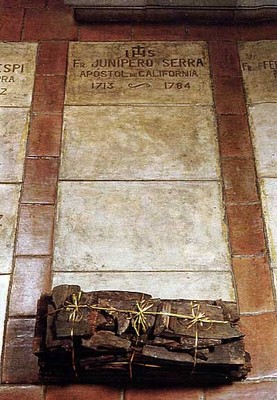
A fanciful depiction of the ceremony held by Padre Serra under the Vizcaino Oak to formally establish the Mission at Carmel.
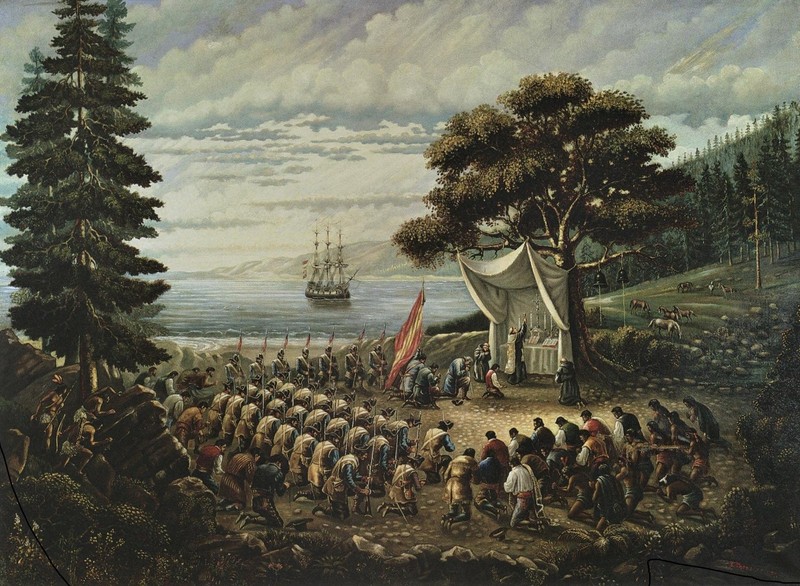
Portrait of Hippolyte Bouchard, a Frenchman who fought for Argentina during their war for independence against Spain. Given letters of marque to operate as a privateer in the Pacific, he later raided the Spanish settlement at Monterey.
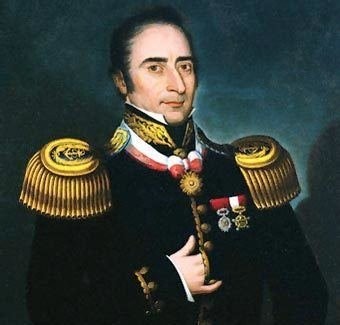
Backstory and Context
Text-to-speech Audio
Alta California was first discovered in 1542 by the Spanish explorer Juan Rodriquez Cabrillo, though he never set foot on the shore of Monterey Bay. It would be another sixty years before another European actually landed--Portuguese explorer Sebastian Vizcaino, who described the location in his logs and performed a ceremony under a huge oak on shore in 1602. Another European landing would not occur for 167 years. By the 1750s, however, Spain had established a strong hold over present-day Mexico and Baja California, and were looking to expand northward before other European powers claimed the fertile lands reported by Cabrillo, Vizcaino, and others.
In 1769, the Spanish began to expand into Alta California in earnest, establishing a Mission in San Diego as the first in a chain of religious and military outposts along the coast. Later that year, Spanish soldier Gaspar de Portola led an overland voyage looking for the harbor “sheltered from all winds” described by Vizcaino. Confused by the Portuguese sailor’s description--Portola had only soldiers and landsmen in his party, whereas Vizcaino had described the harbor in sailors’ terms--the Spaniard failed to recognize the site and simply planted a cross on the shore of Monterey Bay as a landmark before continuing north to Santa Cruz.
The following year, Portola returned, still searching. Coming upon their cross from the year before (now decorated with Native American items like arrows, feathers, mussels, and fish) in better weather than the previous year, even Portola could not fail to recognize Vizcaino’s fabled harbor. When a ship bearing Padre Junipero Serra, sick from an illness caught in San Diego, arrived several days later and recognized the harbor from seaward based on Vizcaino’s description, the decision was sealed to establish the Mission of San Carlos Borromeo on the site.
Serra performed the ceremony under Vizcaino’s great oak, formally establishing the Mission on June 3, 1770. The first mission was erected at the Presidio (fort) of Monterey, where resides the present-day San Carlos Parish Church. Unfortunately, lack of usable agricultural land and proximity to the Spanish troops at the Presidio, who had a habit of mistreating the Native Americans Padre Serra hoped to convert, caused the Presidente to move the Mission five miles south, closer to the Carmel River (named for the Carmelite Catholic fathers who had accompanied Vizcaino over a century-and-a-half before).
With some distance between the Mission and the troublesome soldiers, San Carlos began to flourish as wood, thatch, and mud structures gave way to adobe and then stone. Dependence on supplies delivered by ship from Mexico slowly diminished as more Native Americans joined the Mission as neophytes and the surplus of crops increased. Meanwhile, the Spanish continued to expand their hold, breaking an overland route between their capital in New Spain (Mexico) and Alta California in 1774. By 1783 (as the American Revolution came to an end), enough skilled artisans and trade goods had arrived in Monterey for a large adobe church to be built. Padre Junipero Serra died the following year. The modest dormitory where Serra lived and slept can be visited to this day.
Padre Fermin Lasuen succeeded Serra as Presidente, and worked to build a new church entirely of stone, quarried from the nearby Santa Lucia Mountains and completed in 1797. The first two decades of the 1800s, however, would bring trouble as well as progress. In 1803, an influenza epidemic killed 86 neophytes and caused many of the others to flee, and in 1814, a massive earthquake (which impacted several of the Missions) collapsed the roof of the stone church. In late 1818, a French-Argentine corsair named Hippolyte Bouchard attacked Monterey as part of the new nation of Argentina’s war of independence against Spain. With several hundred men and two ships, he overwhelmed the 65-man garrison of the Presidio and seized Monterey, destroying all military goods and sacking the city of supplies before moving on to Mission Santa Barbara. Mission San Carlos itself was unharmed, but in 1822 Padre-Presidente Vicente Sarria received news of the Hidalgo Revolution in Mexico, which now meant that Alta California was no longer part of Spain.A succession of governors unfriendly to the Missions--which were largely seen as a symbol of Spanish rule--forced many of the Franciscan establishments into sharp decline. In 1827, French Captain Auguste Duhaut-Cilly described his visit:
“[The Mission] is poor and almost depopulated of Indians….[Father] Sarria was at that time in utter disgrace with the Mexicans for having refused to swear to the constitution and for having prevented his subordinates from doing so. Thus, he was sort of a prisoner at San Carlos, where they kept an eye on him. Since the agents of the government considered him the principal obstacle to the adherence of all the missionaries, they would have liked to send him back to Mexico.”1
The government’s hostility culminated in 1834, when the Mexican government secularized the Missions, removing them from the control of the Franciscan padres in the name of “returning” the land to its rightful owners, the Native Americans who predated Spanish colonization. In reality, the Missions and their assets were usually auctioned off to wealthy landowners. Mexican Governor Pio Pico had plans to sell San Carlos in 1846 when he was deposed by American annexation the following year. The American government returned San Carlos to the Catholic church in 1859.
By then, the church had fallen far into ruin. Fresh efforts began to restore it in 1882, however, and in the following years the bodies of Padres Serra, Lasuen, and two other Franciscan friars were exhumed and reinterred at their original sites at the Mission. A temporary roof installed at that time was finally removed and a historically accurate stone roof restored in 1936 by Harry Downie, a cabinetmaker originally hired to restore a few rooms of the Mission, but whose role expanded to entire structure--upon which he spent the next fifty years. The restored church was designated a minor basilica by the Catholic Church in 1960. In 1925 the original bell (made in Mexico in 1807 and thought lost after the 1834 secularization) was restored, making San Carlos the only Mission to retain its original bell and belltower.
Further restorations took place in 2012 and 2016, and a much larger $20 million renovation campaign is planned for the 250th anniversary in 2020. The Mission is a popular tourist destination, featuring many restored structures and a museum.
The Mission was badly vandalized in 2015, a few days after the Catholic church canonized Padre Junipero Serra. A statue of the priest was toppled and splattered in white paint, and graffiti with the words “Saint of Genocide” was present in various places around the Mission grounds. As forced labor, brutal punishments, and cultural oppression are also a part of the Mission legacy, the canonization of Serra was a cause of consternation among Native tribes across California.
Sources
2. Paddison, Joshua. A World Transformed: Firsthand Accounts of California Before the Gold Rush. Berkeley, California. Heyday Books, 1999. Accessed through Archive.org
3. Rothal, Jeff. A Tree and a Chair. Pacific Grove Museum of Natural History. June 12, 2015. Accessed March 13, 2019. https://www.pgmuseum.org/blog/2015/6/12/a-tree-and-a-chair.
4. Kamiya, Gary. When Argentina Attacked Monterey. San Francisco Chronicle. November 11, 2017. Accessed March 13, 2019. https://www.sfchronicle.com/news/article/When-Argentina-attacked-Monterey-Part-I-12348567.php.
5. February/March 2011 Newsletter. California Missions Foundation. March 01, 2011. Accessed March 13, 2019. http://archive.constantcontact.com/fs036/1104038855591/archive/1104678833010.html.
6. Sernoffsky, Evan. Carmel mission vandalized after Junipero Serra’s canonization. SFGate. October 18, 2015. Accessed March 13, 2019. https://www.sfgate.com/news/article/Carmel-Mission-vandalized-after-Junipero-6533431.php#photo-8681360.
